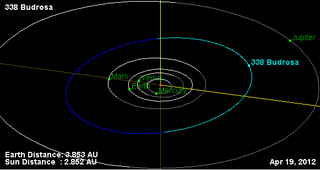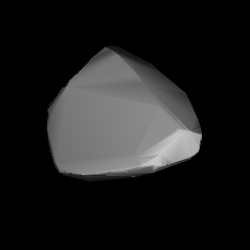
199 Byblis is a medium-sized main belt asteroid.

Vincentina is a fairly large main belt asteroid.

Coelestina is a typical main belt asteroid.

Dresda is a typical Main belt asteroid. It belongs to the Koronis family of asteroids.

Atropos is a typical Main belt asteroid that was discovered by Austrian astronomer Johann Palisa on 8 March 1888 in Vienna.

Budrosa is a large Main belt asteroid. It is classified as an M-type asteroid. It was discovered by Auguste Charlois on 25 September 1892 in Nice.

343 Ostara is a background asteroid from the inner region of the asteroid belt. It was discovered by German astronomer Max Wolf at the Heidelberg Observatory on 15 November 1892.

394 Arduina is an asteroid from the central regions of the asteroid belt. It was discovered by A. Borrelly on 19 November 1894 in Marseilles.

Nassovia is a minor planet orbiting the Sun. It is a member of the Koronis family of asteroids.

621 Werdandi is a Themistian asteroid.
623 Chimaera is a minor planet, specifically an asteroid orbiting in the asteroid belt.
625 Xenia is a minor planet orbiting the Sun. It was discovered by August Kopff in Heidelberg, Germany, on 11 February 1907. The name may have been inspired by the asteroid's provisional designation 1907 XN.

662 Newtonia is a minor planet, specifically an asteroid orbiting mostly in the asteroid belt.
668 Dora is an asteroid orbiting in the asteroid belt located roughly between the orbits of the planets Mars and Jupiter. The name may have been inspired by the asteroid's provisional designation 1908 DO.
768 Struveana is a minor planet orbiting the Sun. The asteroid was named jointly in honor of Baltic German astronomers Friedrich Georg Wilhelm von Struve, Otto Wilhelm von Struve and Karl Hermann Struve.
818 Kapteynia is a minor planet orbiting the Sun. This asteroid is named for the Dutch astronomer Jacobus Kapteyn.
872 Holda is a minor planet orbiting the Sun.

915 Cosette is an S-type asteroid belonging to the Flora family of Main Belt asteroids. Its rotation period is 4.445 hours.
966 Muschi is a main belt asteroid. It was discovered on 9 November 1921 by the German astronomer Walter Baade out of the Hamburger Sternwarte. Baade named the asteroid after his wife's nickname.
6144 Kondojiro (1994 EQ3) is an asteroid discovered on March 14, 1994 by Kin Endate and Kazuro Watanabe at the Kitami Observatory in eastern Hokkaidō, Japan. It is named after Jiro Kondo, a Japanese Egyptologist and professor of archaeology at Waseda University.












